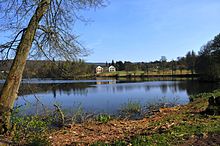Wilhelmsthaler See
The Wilhelmsthaler See is a reservoir in the Wilhelmsthal district of the Gerstungen municipality in the Wartburg district in Thuringia . Built around 1715, it is considered the oldest dam in Thuringia.
Location and dates
The Wilhelmsthaler See is located about six kilometers south of Eisenach on the edge of the Wilhelmsthal location in the immediate vicinity of federal highway 19 . At an up to 7 m high earth dam, the second order Elte water is dammed into a lake with a storage volume of up to 220,000 m³. Due to the height of the reservoir, the reservoir is classified as a category 3 dam according to the regulations in force in Thuringia.
history
The Wilhelmsthaler See was built around 1715 as a gondola pond for the recently built pleasure and hunting palace Wilhelmsthal . Boat trips and walks in the vicinity of the castle were popular pastimes for the aristocratic court society. Called ship carpenters overtook and completed the stock of boats and boathouses on behalf of Duke Ernst August . A luxury yacht based on the Venetian model was armed with 12 miniature cannons. Goethe later noted:
- The condemnation that we consume the country's marks leaves no blessing of comfort.
The outlet to the west of the lake was provided with a bridge. The flowing water rushed over a sloping ramp from stone blocks to the valley. A mill ditch, which has now disappeared, led to the side on the southern slope to the nearby grinding mill, built in 1716 by the forester Johann Heinrich Köhler. This building, which had also disappeared, was approved as part of an economic settlement planned by Duke Johann Wilhelm von Sachsen-Eisenach, in which workshops and a glassworks were to be located. However, these plans of the duke were no longer realized.
The lake, which was only dammed up by an earth dam, could pose a threat to the inhabitants of the lower Elte Valley. After news of devastating dam bursts accumulated, in 1799 the future building officer Georg Christian Sartorius was entrusted with the inspection of the Wilhelmsthal dam. Sartorius monitored the reinforcement of the dam body by stacking stone blocks on the downstream side, the additional weight was supposed to counteract the back pressure of the lake. The purpose of this work was veiled with beautification work on the weir, the certainly considerable costs were approved and carried out with the involvement of numerous unskilled workers from the villages downstream, which led to a general calm. Sartorius reports on this work in his memoir:
- In 1799 I received an order to go to Wilhelmsthal in order to lead the lead of large granite blocks, which were used to decorate a weir that was supposed to form a waterfall - large stones had to be transported - one of them weighed 200 hundredweight . In the same year the weir was built, and for the first time I came into contact with Grand Duke Carl August in business dealings.
Another problem only became acute in the 1980s: the suspended solids and pebbles carried along by the Elte's water were deposited on the lake's receiving waters due to the lack of a gradient. The lake silted up, a working group of the Erfurt amelioration combine had to restore the flow in the lake after a storm in May 1987 by dredging a channel. The intervention, which was paid for by means of disaster control, only brought short-term relief. From the mid-1990s, the lake was temporarily drained. The calculated costs for the complete removal of the sediment body prevented a deep dredging. Since the renewed flooding, the lake has been used for recreational purposes again.
In June 2009 the lake with castle and landscape park was taken over by the Thuringian Palaces and Gardens Foundation . In 2011, along with the landscape park, the inlet area of the lake was also thoroughly renovated and redesigned. In 2015, safety measures were carried out on the dam. To stabilize the structure, the land side of the dam was reinforced and the slope of the dam was flattened. At the same time, the dam will be raised by one meter in order to be able to reach the historical water level again. In order to be able to replant the land side of the dam without rooting the dam, a special layer of liquid soil is applied that is sealed against the dam.
reachability
The lake is located directly on the B19. It can be easily reached via the stops Wilhelmsthal and Wilhelmsthaler See with the Wartburgmobil bus from Eisenach and Bad Liebenstein .
Individual evidence
- ↑ a b Heiko Kleinschmidt: The New Castle in Wilhelmthal shows itself completely in white , Thüringer Allgemeine / Eisenacher Allgemeine from December 9, 2015
- ↑ RF: A pleasure boat on the "Wilhelmsthaler Teich" . In: Das Volk (local page Eisenach) . Erfurt November 16, 1977.
- ↑ Heinrich Weigel: Plans for the commercial development of the upper Eltetal . In: Antiquariat und Buchhandlung St. Georg (Hrsg.): Eisenacher Land . Issue 1. Eisenach 1997, p. 21-23 .
- ^ Heinrich Weigel: Georg Christian Sartorius . In: Antiquariat und Buchhandlung St. Georg (Hrsg.): Eisenacher Land . Issue 2. Eisenach 1997, p. 28-32 .
- ^ NN: Dredging in the Wilhelmsthaler See . In: The people . Erfurt August 14, 1987, p. 5 .
- ↑ Reports on the progress of the work in the Eisenach local press (around 1995 to 2000)
- ↑ Wolfgang Hirsch: "Splendor and Glory in Cultural Policy". Thuringian regional newspaper June 6, 2009
- ↑ Wolfgang Hirsch: "An Arcadian place from brilliant times". Thuringian newspaper, August 8, 2009
Web links
Coordinates: 50 ° 55 ′ 15 ″ N , 10 ° 18 ′ 11 ″ E



